How To Keep Ti Leaf Plant Growing Short
The Hawaiian Ti plant, Cordyline fruticosa, may sound like an unusual name, only it's well-loved by those who favor charismatic houseplants.
Among a few of its names are the Baby Doll, Ti Foliage, and the Good Luck constitute.
The leaves are large, long, and predominately majestic with a flash of pinks, greens, whites, or cream colorations.
Living in the tropical regions of Australia, Southeast Asia, and some of the Hawaiian Islands, this constitute is rather resilient.
A lot of people choose to plant them outdoors as a landscape shrub.
This commodity volition look at everything you demand to know about the Hawaiian Ti care indoors so that it can bring your home expert luck!
Hawaiian Ti Intendance
To care for a Hawaiian Ti provide it with well-draining peat-based potting soil and a temperature between 64-79°F (18-26°C) and bright indirect sunlight. Water once every 7 days and provide a humidity between 40-sixty%. Fertilize bi-weekly in spring and summer using a nitrogen-rich fertilizer at 1/2 strenght.

Hawaiian Ti Care
Contents
- 1 Hawaiian Ti Care
- 2 TI Care GUIDE
- two.i SOIL
- 2.ii Light
- 2.3 WATERING
- two.four TEMPERATURE
- two.5 HUMIDITY
- 2.6 FERTILIZER
- 2.7 PROPAGATION
- 2.viii GROWTH
- ii.9 POTTING
- 3 WATERING YOUR HAWAIIAN TI PLANT
- four TI Found PROPAGATION TECHNIQUES
- 5 HAWAIIAN TI PLANT PESTS
- half-dozen TELLTALE SIGNS OF A HAWAIIAN TI Found
- 6.1 TELLTALE SIGN #i: LEAVES TURNING BROWN
- half-dozen.2 TELLTALE SIGN #2: Xanthous LEAVES
- half-dozen.3 TELLTALE SIGN #three: LOSS OF LEAVES
- half dozen.4 TELLTALE SIGN #four: SPOTTED LEAVES
- 7 5 STEPS TO A HAPPY TI Found
- 8 FREQUENTLY ASKED QUESTIONS Virtually TI Constitute CARE
- 8.1 Is the Hawaiian Ti Plant poisonous to dogs?
- 8.2 Is the Hawaiian Ti plant an annual or perennial plant?
- 8.3 How do y'all clip a Hawaiian Ti establish?
TI CARE GUIDE
Did yous know that people in one case used the leaves off of Cordyline fruticosa for multiple purposes, including thatching their roofs, plates and cups, fishing lures, woven sandals, and traditional hula skirts?
It truly was a luck-providing plant.
Merely, in order to use it, they had to nurture the growth.
Although you lot simply want them to adorn your house with a tropical plant, you should still take special care of them. We've got you covered!
SOIL
Hawaiian Ti plants grow well in well-draining soil.
Peat-based potting soil works best for a Hawaiian Ti institute.
You don't want the roots to sit down in water.
This will lead to root rot. You can choose just nigh whatsoever blazon of soil, even clay, every bit long as there are drainage holes.
Adding organic matter such equally peat moss or perlite. For those who want to get technical, a pH betwixt half dozen.0 and half-dozen.5 is optimal.
Calorie-free
Hawaiian Ti needs bright indirect sunlight to thrive.
Those colors that you see presented on the leaf tin can exist a bit sensitive to the amount of dominicus that they become, however, then be mindful.
They do need bright indirect sunlight for the bulk of the day.
Avert vivid direct low-cal equally it might scorch the leaves.
A couple of direct sunlight (three-4 hours) in the morning is fine.
This is often the instance when placing Ti plants into an eastern-facing window.
Unfortunately, straight exposure tin can make the leaves lose their vibrancy.
Those who go along their Cordyline fruticosa outdoors struggle with finding an acceptable spot.
Keeping one of these plants indoors is a bit easier. As explained in our article pertaining to light levels , indirect sunlight needs to laissez passer through another object first.
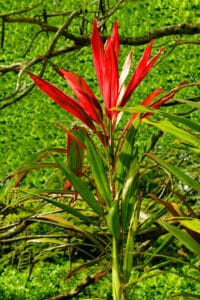
Hawaiian Ti prefers vivid vivid indirect calorie-free
WATERING
Water Hawaiian Ti one time every 7 days.
The soil of a Hawaiian Ti plant should be kept consistently moist, without beingness oversaturated.
This is typically accomplished through less frequent watering sessions where more h2o is added at one fourth dimension.
Y'all should exist sure to let the institute dry out some before moving frontward with your adjacent session, existence careful to not let the soil get completely dry.
You should likewise be mindful of the dissimilar chemicals that your water may have since these can alter the leaf's vitality.
We will go over this after on in the commodity.
TEMPERATURE
Hawaiian Ti needs temperatures between 64-79 °F (xviii-26°C).
Cordyline fruticosa isn't picky when it comes to temperature.
This makes it quite piece of cake for those who choose to enhance their Ti plant indoors. They can actually survive in a wide range
This can exist every bit low as 18 degrees Celsius, all the style up to 26 degrees Celsius. Whatsoever surroundings lower than 15 degrees Celsius can potentially damage the overall state of your Hawaiian Ti establish.
Another factor to consider is the number of drafts that your business firm experiences.
Cull the location of your plant carefully, typically in a room that is on the warmer terminate of the spectrum.
HUMIDITY
Provide a Hawaiian Ti establish with twoscore-60% humidity according to the University of Hawaii.
You lot might await a tropical plant, such as the Hawaiian Ti constitute to need high levels of humidity.
In fact, it isn't all that essential. Your firm can accept average, or even depression levels of humidity and it would be only fine.
The real play a trick on is to just make sure that the air doesn't get overly dry.
This volition manifest in several catastrophes such as the leaves losing their colour or the plant dying altogether.
There take been a few specialists who that country higher humidity will increase the vibrant coloration of the leaf.
So, I suggest that you try to keep your home's humidity relatively loftier without worrying virtually beneath-average levels.
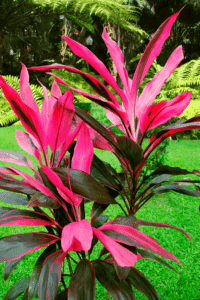
Hawaiian Ti thrive in a humidity level betwixt 40-60%
FERTILIZER
Fertilize Hawaiian Ti bi-weekly in spring and summer using a fertilizer high in nitrogen at 1/2 strength.
These plants abound clusters of flowers, though they are only virtually half an inch in their overall width (1.3cm).
Fertilizers are typically used when a plant needs help with the growth of flowers and fruits.
With such a small bloom production, the Ti plant does not necessarily require the employ of fertilizer.
In fact, the just time that y'all should consider any food is during the growing season, at about 2-week intervals.
The fertilizer that you choose should be high in nitrogen and diluted to about one-half of its intended strength.
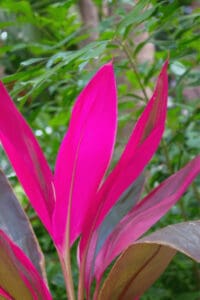
Fertilize Hawaiian Ti plants bi-weekly in the growing season
PROPAGATION
You can propagate Hawaiian Ti using the stalk cutting method or by partitioning.
Y'all may have heard us talk nigh how like shooting fish in a barrel information technology is to copy your parent plant through the act of stem cuttings.
This is just i of the methods that individuals use to propagate their Hawaiian Ti plant.
You can also go almost this through cane cuttings, plant division, and air layering.
The stalks on your plant need to exist quite wide for air layering to work.
Stem cuttings and institute division are our preferred methods of copying your beloved Cordyline fruticosa.
GROWTH
Hawaiian Ti is a relatively quick grower and can reach a pinnacle of 10 feet (3 meters).
Did you know that information technology tin only take about v weeks for them to achieve well-nigh their full size? That's phenomenal!
Once reaching full maturity, the Ti establish can often reach heights of nearly 10 feet with a width of four anxiety. This may sound a bit overwhelming for someone who wants to keep it indoors.
Well, you can stop this from happening. By making incisions to the stem itself, you'll discourage such growth.
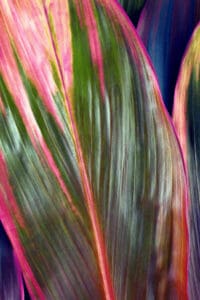
Hawaiian Ti leaf
POTTING
For the first few years, expect to transfer your Hawaiian Ti establish to a new dwelling space every two years or so.
Making certain that the roots have ample infinite to grow is fundamental in keeping this found salubrious.
Calculation loam-based soil over the roots can aid keep the budding flora happy.
Once it has reached its full potential, you'll only need to repot every 3 or four years.
This may be a dainty break from your higher-maintenance flowering plants.
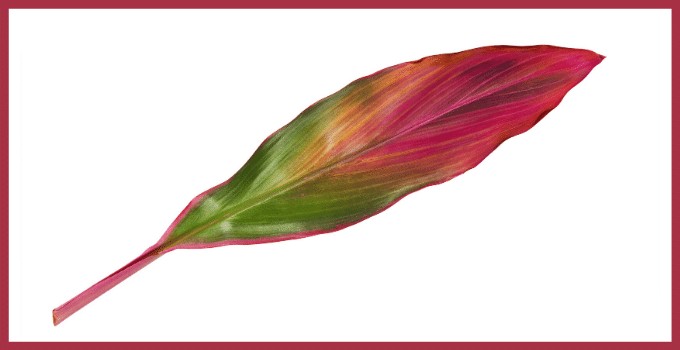
Hawaiian Ti plants are known for their cute, tricolor foliage.
WATERING YOUR HAWAIIAN TI PLANT
Unfortunately, figuring out the right amount of h2o is among the hardest parts of owning a Hawaiian Ti plant.
The soil needs to exist kept considerably moist, without allowing the roots to become soggy. When implementing a schedule, choose to water less frequently with more water at once.
You may besides cull to add a daily misting to your routine as this will help to increase water without over saturating.
Certain households may have h2o that contains too much fluoride or chlorine in their tap water.
If you feel that this might be the case, go on to water with distilled water.
TI Institute PROPAGATION TECHNIQUES
The nigh common techniques chosen for the propagation of a Hawaiian Ti plant are through pikestaff or stalk cuttings, plant divisions, and air layering.
In this section, we will focus on stalk cuttings, as it can be quite elementary. Even for beginners!
PROPAGATION THROUGH CANE CUTTINGS
- Identify a healthy pikestaff, cutting it into pieces that are at least an inch in length.
- Place your cane cuttings into a pot with fresh soil with organic thing such as perlite, moss, and vermiculite. The canes should exist put on their side and buried nether the pinnacle layer of soil.
- Move your pot to a warm area of the house that has fractional shade.
- Keep to mist your cuttings multiple times a day.
- After four to 6 weeks, yous should start to see roots develop. Once this happens, transfer them to a larger pot.
HAWAIIAN TI Establish PESTS
Cordyline fruticosa is a rather resilient plant, though it can be affected by a number of pests.
Knowing how to tackle these terrible foes can relieve your institute from imminent danger.
Hither are the most common bugs and diseases that you lot could find on your Ti plant.
Arthropod invaders include mealybugs, mites, scales, thrips, and mucus gnats.
The loss of your leaves, sudden spots, and stunted growth tin can insinuate to these pests.
You can choose to tackle this problem with a homemade or store-bought insecticide, but that can sometimes be besides much for the leaves.
We recommend researching which problems you're dealing with and then proceeding to use water to hose off any potential eggs.

Hawaiian Ti Intendance
TELLTALE SIGNS OF A HAWAIIAN TI Plant
Plants are actually able to tell you lot what'due south incorrect, as long every bit you know what you are looking at.
We accept taken the liberty to compile the iv typical problems and how to go most solving them.
TELLTALE SIGN #ane: LEAVES TURNING BROWN
Cause: The average colour of a Ti plant's foliage ranges from red to dark-green. Brown, on the other mitt, can be a sign of a few dissimilar issues.
These include overwatering, too much sunlight, or an excess of warm temperatures.
Remedy: The easiest out of these to solve is sunlight. Move your constitute to a location where there is less direct sunlight.
If this doesn't fix the problem, move on to adjusting the watering schedule.
TELLTALE SIGN #2: Xanthous LEAVES
Cause: The yellowing of leaves is a scrap more straightforward. This is a articulate indicator that the leaf is being scorched from sunlight that is too direct.
Remedy: The best thing you tin do for a xanthous-leafed Ti plant is to change its location in the house. Observe a spot that has plenty of warm, indirect sunlight.
TELLTALE SIGN #3: LOSS OF LEAVES
Cause: If yous notice that the lower leaves have started to dry up and autumn, you tin be pretty sure that it is a result of underwatering.
Remedy: Readjust your watering schedule and consider implementing a misting schedule. It's important to let the institute dry out betwixt sessions, just not also much.
TELLTALE SIGN #four: SPOTTED LEAVES
Cause: Past now, y'all might have noticed that the leaves are a big indicator that there might be something wrong. Spots located on the foliage are due to a fungal pathogen.
Remedy: Unfortunately, it is tricky to determine which fungus your plant has. Nosotros suggest that you lot only contact an expert on the affair at your local plant nursery.
FIVE STEPS TO A HAPPY TI PLANT
Just to brand things piece of cake, nosotros've added a list of the five nigh important intendance facts related to your Hawaiian Ti plant!
- Feel costless to use whatever soil type as long as there are drainage holes!
- Choose a spot that has bright, indirect sunlight for your Ti found.
- Your house should stay somewhere betwixt 18 and 26 degrees Celsius.
- Only utilize fertilizer if you're certain that you lot won't damage your plant. It isn't entirely necessary after all.
- Find the correct watering schedule for your institute then that the soil stays relatively moist without getting as well dried out.
Ofttimes ASKED QUESTIONS ABOUT TI PLANT Care
Is the Hawaiian Ti Establish poisonous to dogs?
Hawaiian Ti plants are poisonous to cats and dogs. They comprise toxins that, when ingested, are toxic to your animals.
Is the Hawaiian Ti establish an annual or perennial establish?
Hawaiian Ti plants are perennials, meaning that they live more two years.
How do you prune a Hawaiian Ti found?
Prune a Hawaiian Ti found will help it from becoming besides tall for your home. The general rule of thumb is that you tin safely clip back any of the stalks as long equally it is six inches from the top of the soil. Don't touch any growth that is closer than that.

Marcel runs the place around here. He has a deep passion for houseplants & gardening and is constantly on the lookout for yet another special plant to add to his arsenal of houseplants, succulents & cacti.
Marcel is likewise the founder of Iseli International Commerce, a sole proprietorship company that publishes a variety of websites and online magazines.
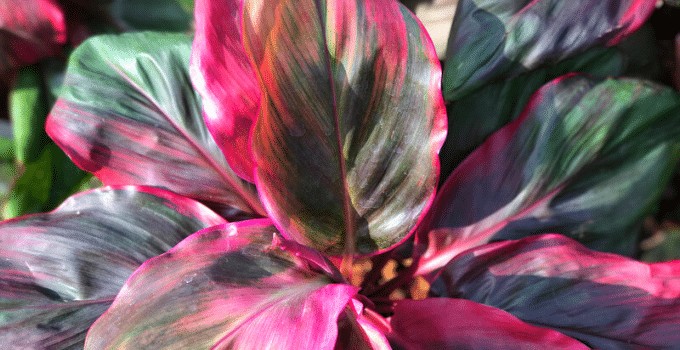
How To Keep Ti Leaf Plant Growing Short,
Source: https://plantophiles.com/plant-care/hawaiian-ti/
Posted by: walkerwalonly35.blogspot.com


0 Response to "How To Keep Ti Leaf Plant Growing Short"
Post a Comment